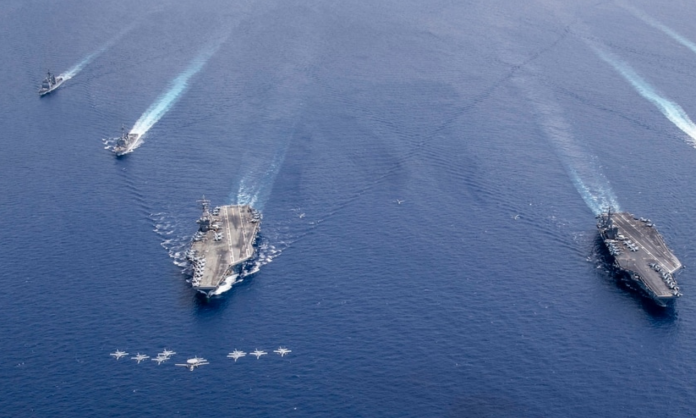Today, for the first time since the USSR developed its own atomic arsenal to challenge US nuclear hegemony, the world faces the realistic possibility of a war between great powers that might not immediately end in the mutual destruction of both sides and the end of all human civilisation. If anything, that makes the war more likely. We have to do whatever we can to stop it from happening.
For nearly half a century, the world lived with the knowledge that the rulers of both the US and the USSR could, in the space of a few minutes, make decisions that would wipe us all out in a global cascade of white flashing death. It was a strange horror. The threat was not the prolonged suffering that the two world wars and centuries of colonial barbarism had inflicted – year upon year of accumulating loss and death and grief – but instant annihilation, the erasure of a whole world of civilisation in a matter of hours.
The Cold War was not always cold. Localised wars in Korea, Vietnam and elsewhere left millions dead. But these conflicts, terrible though they were, didn’t seriously threaten to transform into a direct confrontation between the superpowers. Regardless of the fever-dreams of unhinged presidents like Richard Nixon, who, Trump-like, fantasised about a nuclear strike on Hanoi, the logic of the Cold War built a wall between proxy skirmishes and the main game: the prospect of total war between the US and the USSR. And on that front, in spite of some enormous scares – like the Cuban missile crisis of 1962, when Kennedy and Khrushchev brought the world as close as it has come to war between nuclear powers – neither party ever passed the point of no return.
The macabre logic of the “deterrence” policy pursued by both sides assumed that direct major confrontation between the superpowers would inevitably turn into a full-scale nuclear war. It was all or nothing.
Today, this assumption has been junked. The military strategists of the US, China, and other countries including Australia, are planning for conventional war between the great powers, or “limited” nuclear conflicts that do not involve the flattening of Beijing or New York.
The official US Cold War policy of “deterrence” was the logic of the lunatic asylum. Peace, according to the doctrine, could only be assured if the other side was convinced you were insane enough to destroy the world, even if it meant your part of it was obliterated as well. But while it was an unhinged policy that risked the annihilation of all life on the planet in the hope that no-one would make any miscalculations – that no false alarm would precipitate an Armageddon – it actually represented the more moderate opinion among Pentagon strategists. The war-hawks bristled at deterrence. From their point of view, all it meant was you couldn’t have proper wars.
In the 1980s, US military strategists put considerable effort into figuring out how they could win a full-scale war with the USSR by taking out Soviet nuclear missile sites before they were able to send their deadly payloads towards US cities. It was never really feasible.
Today, the idea of winning a total war has been replaced with the argument that it is possible for great powers to fight a partial war. Such a prospect is terrifying, not only because such a war could easily spiral into a total nuclear confrontation, but because even if this did not happen, a regional war between the US and China would mean death and destruction on a scale unseen since the world wars.
What makes the idea so dangerous for humanity, but also so alluring for the warmongers, is that it makes war – real, large scale war between armed-to-the-teeth powers in possession of the most terrible weapons – possible. If the only kind of war with China possible was a total war – a nuclear confrontation in which every major city in the combatant countries would likely be obliterated – no one would be for it. But a medium scale war in the South China Sea? It sounds serious, but not unthinkable.
This is what Peter Dutton is warning us about, and it’s what the military is actively planning for. So let’s think through what it would look like.
China has been preparing for an invasion of Taiwan for at least two decades. Over the past 20 years, it has significantly modernised its military. While it still lags behind the US, it is now streets ahead of any other power in terms of military capacity.
According to the 2020 US Department of Defence report to Congress, “China has already achieved parity with – or even exceeded – the United States in several military modernization areas”, including shipbuilding, land-based conventional ballistic and cruise missiles, and integrated air defence systems.The Chinese ground-launched ballistic and cruise missile systems are designed to take out US bases and naval assets scattered across Asia and the Pacific. Its sophisticated anti-access/area denial system could now have the capacity to neutralise US bases in Japan and South Korea, and the previously unassailable US Pacific fleet, in particular its aircraft carriers.
There is no guarantee at all that the US military would win a war in the South China Sea. That’s why there is currently an intense discussion in US policy circles about whether the US should contemplate fighting such a war in the eventuality that China invaded Taiwan, or carried out some other provocation.
If such a war did take place, it would be horrifically bloody. Hundreds of thousands of Taiwanese and Chinese soldiers could be killed in the fight to determine whether China could occupy Taiwan. If the US intervened, China would likely attack US bases in South Korea, Japan and Guam. The death toll could be astronomical. The US military is used to winning its wars. If the core of its Pacific fleet was destroyed by Chinese land-to-sea missiles, or by China’s extensive submarine fleet, the pressure to respond with overwhelming force – which means, in a situation where geography and geopolitics put the US at a profound strategic disadvantage, intercontinental nuclear weapons – would be enormous.
What is Australia’s role in this situation? Some Australian policy analysis suggest that because the US is in a weak position militarily, Australia needs to fast-track its own military development, and establish a fighting force that could play a serious role alongside the US in a future war with China.
There is already considerable pressure to increase Australia’s military capacity. Josh Frydenberg’s 2021 budget allocated a staggering $270 billion in military spending over the next 10 years. “We need to be prepared for a world that is less stable and more contested,” he said in his budget speech.
Australia is used to fighting its wars on a minimum casualties, maximum flag-waving-opportunity basis. That is not what Australian involvement in a US-led war with China would be like. The approach Australia took in Afghanistan – committing a tiny number of elite special forces who had overwhelming technological superiority over their opponents and thus a very low casualty rate – would not be at all viable.
Australian warships and submarines, even if remote from the actual battleground, would be prime targets, especially in the build-up to war. From China’s point of view, attacking Australian military assets would be a way to send a message of intent which, even if risky, is still less likely to lead to inevitable escalation than attacking US forces directly. In the event of a war between the US and China, Darwin, a base for substantial US as well as Australian forces, would be a likely target for Chinese attack. Large civilian as well as military casualties would be eminently possible in such an eventuality.
This can seem like it’s painting a picture of Australian self-defence in the face of Chinese aggression. Like all rising powers in history, China’s ruling class wants to assert itself, impose its will, expand its sphere of influence and control. But it is also the case that a future conflict with China will be entirely a war of choice on Australia’s part. China poses no threat at all to Australia itself. Even in the most belligerent versions of China’s future there is no prospect of it invading the Australian mainland. An Australian war with China would be entirely about defending the status quo of US hegemony in Asia.
Even before the “pivot to Asia”, the Obama-era policy that Biden looks finally set to implement, the US encircled China’s shores. With major bases in Japan and South Korea, a close ally in Taiwan on China’s doorstep, bases in Guam and Hawaii, and a permanent naval force roaming the Pacific, it is the US, not China, that by any objective measure is the malevolent power in the region. If China had bases and military assets scattered throughout Indonesia, PNG and New Zealand, if the Tasmanian government was its heavily-armed close ally, if China had aircraft carriers stationed in the Great Australia Bight and regularly sent warships through Bass Strait in the name of “freedom of navigation”, then there might be some basis to claim it was the aggressive party.
In fact all the hype about the supposed “Chinese threat” is not about any threat to Australia, but about the threat that China poses to US domination of Asia. If Australia was not firmly on the side of maintaining that domination, there would be no tension with China, no prospect of war, no argument to build up Australian military power.
The prospect of a major war between the world’s two main imperialist powers is a horrifying threat to humanity as a whole, and an argument to dismantle the deranged system of global capitalism that divides the world up into competing blocs and drives them towards bloody conflagrations. But we need to be clear that Australia is no hapless victim in this situation. Our leaders are banging the drums of war not out of fear of some threat to our national sovereignty: there is no such threat. If Australia really does go to war with China alongside the US, it will be entirely because our political leaders want to be involved in such a war.
It is time that we started organising to keep us out of such a calamity. We need to raise our voices and say no to war.









